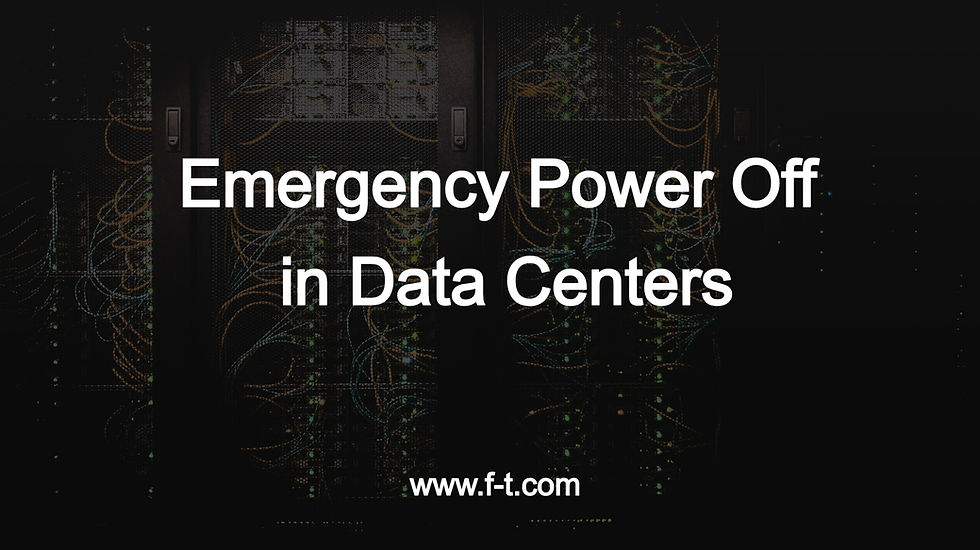Emergency Power Off in Data Centers
- Fitzemeyer & Tocci

- Aug 20, 2020
- 4 min read

Data centers consume a large amount of power, so it’s important to keep everyone safe by providing an effective way for facility staff or emergency responders to disconnect power during emergencies. Power could become a potential hazard in responding to emergencies and can quickly be eliminated through the use emergency power off (EPO) buttons. This article will explore the importance and primary functions of EPO buttons as it pertains to the National Electrical Code. Additionally, the interface between the fire alarm, and HVAC and EPO system as well as the exceptions that allow for the omission of the emergency power off button will be briefly explained.
The main function of EPOs are to disconnect power to equipment serving the data center during emergency situations. Disconnecting power to the equipment will help mitigate potential risks and hazards when facility staff or emergency responders are responding to emergencies, such as fires, flooding, etc., within the data center. This article’s focus will be on the Article 645 in the National Electrical Code (NEC) which pertains to the Information Technology Equipment. The NEC 2020 outlines the following functions for the EPO in Article 645:
Disconnect power to all dedicated HVAC equipment serving the room and close all smoke/fire dampers (NEC 2020 Article 645.10)
Disconnect all power feeding equipment located in the data center. (NEC 2020 Article 645.10)
Disconnect any UPS batteries feeding the space. (NEC 2020 Article 645.11)
Disconnecting power to equipment can be accomplished in multiple ways. The most common method of disconnecting power to data center equipment is through a shunt trip device within the circuit breakers serving the equipment. This configuration allows for the circuit breaker to be controlled from push buttons EPO’s located at “approved locations readily accessible in case of fire to authorized personnel and emergency responders” (NEC 2020 Article 645.10 (A)(1)).
Providing dedicated panelboards serving the data center allow for a simpler EPO design and will reduce the number of shunt trip type circuit breakers necessary to disconnect power to all the equipment. Dedicated panelboards for HVAC, IT equipment, and general electrical loads serving the data center will provide a centralized location for emergency shutdowns and allow for simple circuit management in the future. The location of where the power is disconnected is important to a successful EPO design. Most data center have backup power in the form of a generator, therefore, it is important that the power is disconnected downstream of the transfer switches. Disconnecting power upstream of the transfer switch can lead to various problems such as the downstream panelboard potentially remaining energized.
Most data centers provide their equipment with an uninterruptable power supply (UPS) to keep the equipment energized long enough for a transition from utility power to the generator or vice versa. Therefore, as noted above it is also important to disconnect the batteries of these units when the EPO button is activated as outlined in NEC Article 645.11. Disconnecting power downstream of the transfer switches and disconnecting the batteries of the UPS will ensure that the equipment is not energized. Disconnecting all sources of power to the equipment is essential in keeping everyone safe during emergency situations and all alternative power source need to be accounted for.
The emergency power off system also interacts with the HVAC and fire alarm system. The fire alarm provides early detection of fires and can be used to activate the EPO system for the data center in the event of a fire. The fire alarm system is also utilized to close smoke damper to prevent fire/smoke from spreading to different area. The power to the HVAC equipment serving the data center should also be disconnected when the EPO is activated. The NEC has an exception that allow for critical operations data systems to omit EPO buttons and can be found in NEC 2020 Article 645.10 (B). The requirements to meet the exception are as follows:
An approved procedure has been established and maintained for removing power and air movement in the room/space.
Qualified personnel are continuously available to advise emergency responders and instruct them of the disconnecting methods.
Smoke-sensing fire detection system is in place.
An approve fire suppression system suitable for the application is in place.
Cables under raised floors, other than branch circuits wiring and power cords are installed in in compliance with 645.5(E)(2) or 645.5(E)(3) or in compliance with Table 645.10(B)(5).
Locations of EPO buttons is very important in the design of an EPO system. Well placed, labelled, and protected EPO buttons can reduce the amount of false activation and the overall effectiveness of the system. EPO buttons are typically provided with clear cover and are clearly labelled with the equipment that will be shutdown to avoid being mistaken for devices such as door releases. EPO buttons are commonly located at the entrances/exits of the data centers for easy access in case of emergencies, but the number and locations of EPO buttons will depend on the size of the data center, the Authority Having Jurisdiction and the Fire Marshall. F&T can assist in providing a safe and reliable data center design.

Written by:
Daniel Fung, PE
Electrical Project Engineer




Comments